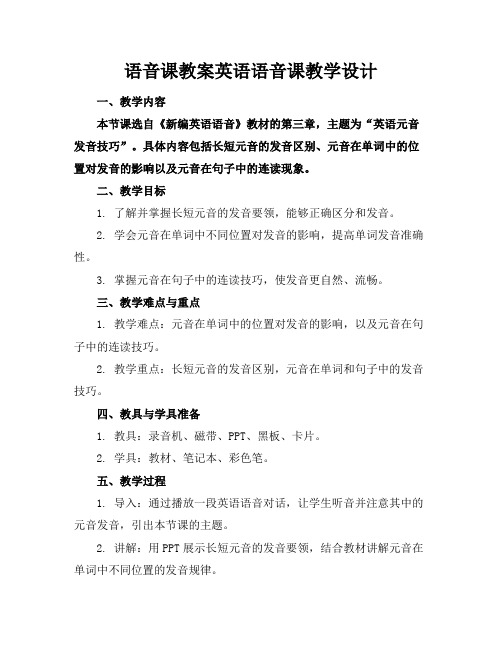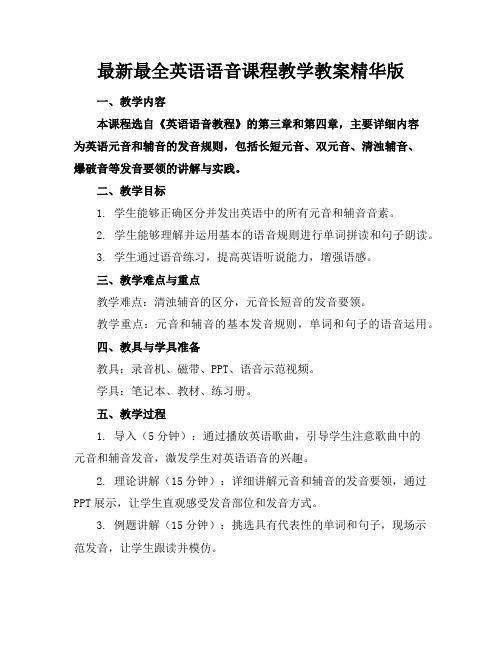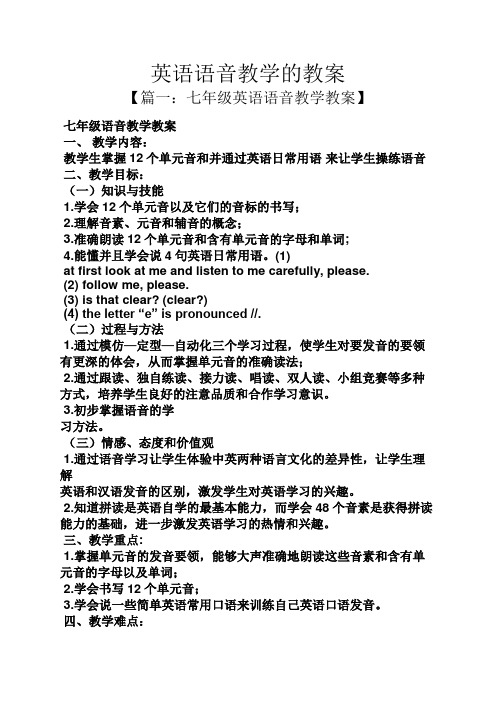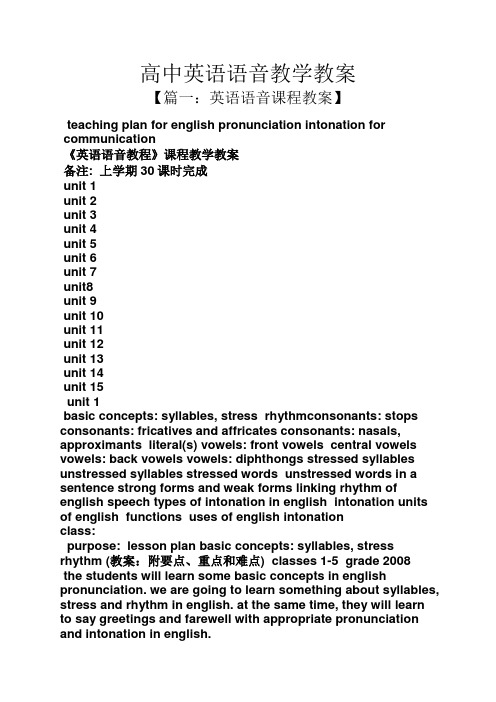英语语音课教学教案设计
语音课教案英语语音课教学设计

语音课教案英语语音课教学设计一、教学内容本节课选自《新编英语语音》教材的第三章,主题为“英语元音发音技巧”。
具体内容包括长短元音的发音区别、元音在单词中的位置对发音的影响以及元音在句子中的连读现象。
二、教学目标1. 了解并掌握长短元音的发音要领,能够正确区分和发音。
2. 学会元音在单词中不同位置对发音的影响,提高单词发音准确性。
3. 掌握元音在句子中的连读技巧,使发音更自然、流畅。
三、教学难点与重点1. 教学难点:元音在单词中的位置对发音的影响,以及元音在句子中的连读技巧。
2. 教学重点:长短元音的发音区别,元音在单词和句子中的发音技巧。
四、教具与学具准备1. 教具:录音机、磁带、PPT、黑板、卡片。
2. 学具:教材、笔记本、彩色笔。
五、教学过程1. 导入:通过播放一段英语语音对话,让学生听音并注意其中的元音发音,引出本节课的主题。
2. 讲解:用PPT展示长短元音的发音要领,结合教材讲解元音在单词中不同位置的发音规律。
3. 实践:让学生跟读录音,模仿长短元音发音,并进行分组练习。
4. 例题讲解:讲解元音在句子中的连读现象,举例说明并引导学生跟读。
5. 随堂练习:设计练习题,让学生进行元音发音、单词发音和句子连读的练习,并及时给予反馈。
六、板书设计1. 板书英语元音发音技巧2. 内容:(1)长短元音发音区别(2)元音在单词中的位置对发音的影响(3)元音在句子中的连读技巧七、作业设计1. 作业题目:(1)列举5组含有长短元音的单词,并标出元音所在位置。
I like to eat apples./ He is reading a book./ We are going to the movies.2. 答案:(1)略(2)略(3)略八、课后反思及拓展延伸2. 拓展延伸:鼓励学生课后观看英语电影、听英语歌曲,模仿其中的元音发音,提高语感。
同时,推荐相关语音学习资料,帮助学生巩固所学知识。
重点和难点解析:1. 教学难点:元音在单词中的位置对发音的影响,以及元音在句子中的连读技巧。
英语教案语音课

英语教案语音课【篇一:英语语音教案】《英语语音》课程教学教案unit 1unit 2unit 3unit 4unit 5unit 6unit 7unit8phoneme and transcription the pure vowels the diphthongs rules of reading of english vowel letters the consonants connected speech (1) connected speech (2) connected speech (3)unit 1 phoneme and transcriptionpurpose:the students will learn some basic concepts in english pronunciation. we are going to learn something about syllables, stress and rhythm in english. at the same time, they will learnto say greetings and farewell with appropriate pronunciation and intonation in english.objectives: students will be able to :1. define - in their own words a definition for “syllable” and “stressedsyllable”, then a definition for “rhythm” and “rhythmic pattern”;2. compare – based on the understanding of the basic concept, compare thedegrees of stress and different rhythmic patterns;3. practice – imitate the typical stress patterns and rhythmic patterns inenglish.activities and procedures:1. begin by asking the class to find out how much thestudents know about stress patterns and rhythmic patters in english, make sure that it serves the purpose of stimulating thestudents to think about the issue and have the desire to find out the answers themselves.2. display examples by playing the recording of the native speakers showing the typical stress patters and rhythmic patterns in english.3. ask the students to listen to the tapes to mark out the stressed syllables in words.4. ask the students to listen to the tapes to mark out the stressed words in sentences.5. have the students imitate the stress patterns and rhythmic patterns to experience the rhythm in speech.6. have the students share what they have learned by reading out the practice materials in pairs.7. have the students listen to the conversations recorded by native speakers of english and try to get the rhythmic patterns in their speech.8. have the students practice the guided conversation. ask them to pay special attention to the stress the rhythm in speech.9. highlight the language function in the conversation in the practice.10. have several pairs of the students present their conversation in the class.11. comment on the students? performance by highlighting the achievement of the students and the efforts they need for the improvement.12. ask the students to do more practice after class and get ready for presentation during the next session.basic concepts: syllables, stress rhythmin this unit, we are going to learn some basic concepts in english pronunciation. we are going to learn something about syllables, stress and rhythm in english. at thesame time, we are going to learn to say greetings and farewell with appropriate pronunciation and intonation in english.first of all, let?s look at the syllable in english.please listen to the following word: driveway.now, tell me, how many syllables there are in this word? right. there are two. please listen to the following sentence: drive him away.tell me, how many syllables there are in this sentence? right. there are four.introductionso. what is a syllable?a syllable is a word part and the basic unit of english rhythm. english words can have one, two, three or even more syllables. in the word ?driveway?, there are two syllables. in the sentence ?drive him away?, there are four.what is a stressed syllable?in english words with more than one syllable, one of them will receive more stress than the others. stressed syllables are those that are marked in the dictionary as stressed. for example, in the word ?driveway?, the first syllable is a stressed syllable while the second syllable is not.stressed syllables in english are usually longer, louder, and higher in pitch. listen to the following example:syllable 1 syllable 2 (short) (long)syllable 3(short)the word banana has 3 syllables. syllable 1 is not stressed and so is short. syllable 2 is stressed and so is long with a clear vowel sound / :/. syllable 3 is not stressed and so is also short. here is a short summary about the stressed and unstressed syllables:stressed syllables are strong syllables. unstressed syllables are weak syllables. stressed syllables:- are long- have a pitch change- have full vowel sounds.unstressed syllables:- are short- often have a reduced vowel sound.now let?s look at the rhythm in english.we all know that correct pronunciation of the individual english sounds is important in communication. the way the sounds are organized, however, is often more crucial for understanding. the rhythm of english, for example, is one of the two major organizing structures that native speakers rely on to process speech.what is rhythm?rhythm can be found everywhere in life: the sound of a clock, the beating of the heart, the strokes of a swimmer, and ofcourse in poetry and music. but rhythm in language is less familiar because it is less obvious. the rhythm of a language is characterized by the timing pattern of successive syllables. in some languages, every syllable is given about the same length, while in others, syllables vary in length. in english, strongbeats are called stress -- the heart of the rhythmic pattern.音节、重音与节奏本单元将向大家介绍英语语音语调的基本概念, 主要介绍英语语音的音节、重音和节奏规律。
《英语语音》课程教学教案

《英语语音》课程教学教案一、教学内容本节课的教学内容选自人教版高中英语选修8,第一单元。
本节课主要讲解英语元音和辅音的发音规则,以及连读、弱读等语音现象。
具体内容包括:1. 元音发音:长元音 /i:, e, ə, a:/ 和短元音 /ɪ, ʊ, ʌ, ɒ/的发音方法及区别。
2. 辅音发音:清辅音 /p, t, k, s, f, ʃ/ 和浊辅音 /b, d, g, z, v, ʒ/ 的发音方法及区别。
3. 连读现象:相邻单词的辅音与元音的连接发音。
4. 弱读现象:某些单词在句子中的发音减弱或省略。
二、教学目标1. 学生能够正确发音元音和辅音,掌握发音规则。
2. 学生能够识别并正确发音连读和弱读现象。
3. 学生能够在实际语境中运用所学的语音知识,提高英语口语表达能力。
三、教学难点与重点重点:元音和辅音的发音规则,连读、弱读等语音现象的识别和应用。
难点:连读、弱读在实际语境中的运用,以及发音时的口型和舌位。
四、教具与学具准备1. 教具:多媒体课件、黑板、粉笔、录音机、磁带。
2. 学具:课本、练习册、录音机、磁带。
五、教学过程1. 引入:通过播放一段英语对话,让学生注意到的语音现象,激发学生学习兴趣。
2. 讲解:讲解元音和辅音的发音规则,以及连读、弱读等语音现象,示例讲解,让学生跟着老师一起发音。
3. 练习:学生跟读课文,模仿发音,教师逐一纠正发音错误。
4. 应用:学生分组进行角色扮演,运用所学的语音知识进行对话,教师巡回指导。
六、板书设计1. 元音发音规则:长元音 /i:, e, ə, a:/短元音 /ɪ, ʊ, ʌ, ɒ/2. 辅音发音规则:清辅音 /p, t, k, s, f, ʃ/浊辅音 /b, d, g, z, v, ʒ/3. 连读现象:相邻单词的辅音与元音的连接发音。
4. 弱读现象:某些单词在句子中的发音减弱或省略。
七、作业设计1. 作业题目:(1) 模仿课本对话,注意连读、弱读的发音。
(2) 找出身边的英语语音例子,分析其发音规则。
小学英语语音课教案

Management is to simplify complicated issues and plan chaotic things.(页眉可删)小学英语语音课教案关于英语语音你还记得多少?小学英语老师怎么备课英语语音的知识?下面是整理的小学英语语音课教案,欢迎阅读。
小学英语语音课教案【1】一、教学目标设计1、学情分析本节课的授课对象是小学四年级学生。
四年级学生经过近两年的英语学习,有了简单的英语基础知识和听说读写的能力;同时,学生对英语学习有着较浓厚的兴趣,喜欢表达自己的观点,也具备初步的自主、合作、探究能力。
2、教学内容本课的教学内容是pep小学英语四年级下册第一、二单元c 部分pronunciation的内容,是一节单纯的语音课型。
四年级上册已经学习了26个字母及例词,学生可以初步了解其中的21 个辅音字母在单词中的读音。
本节课的重点是启发学生通过仔细读单词,自己总结出元音字母aa和ee的发音规律,让学生获得成功感,进而提升自主学习的能力。
3、课标解读小学四年级应达到《义务教育英语课程标准》一级标准。
虽然在课程标准的一级标准里对语音没有明确要求,但有关小学语音教学的二级要求中对语音目标的要求是:(1)知道错误的发音会影响交际;(2)知道字母名称的读音;(3)了解简单的拼读规律;(4)了解单词有重音。
(5)语音清楚,语调自然。
4、教学目标知识目标:能够听懂,会说,会读音标“[ei] [] [i:] [e]和例词cake,snake,grapes, face,apple , bag , cat , hat, we,me , he , she,egg , bed , desk , pen”能力目标:(1)引导学生积极参加小组活动,促进他们养成动脑、动口和动手的好习惯,初步形成主动学习的意识。
(2)培养学生的分析能力。
情感目标:(1)进一步提高学生对英语的学习热情及学习兴趣。
(2)鼓励学生积极主动参与课堂活动,大胆开口,主动模仿。
最新最全英语语音课程教学教案精华版

最新最全英语语音课程教学教案精华版一、教学内容本课程选自《英语语音教程》的第三章和第四章,主要详细内容为英语元音和辅音的发音规则,包括长短元音、双元音、清浊辅音、爆破音等发音要领的讲解与实践。
二、教学目标1. 学生能够正确区分并发出英语中的所有元音和辅音音素。
2. 学生能够理解并运用基本的语音规则进行单词拼读和句子朗读。
3. 学生通过语音练习,提高英语听说能力,增强语感。
三、教学难点与重点教学难点:清浊辅音的区分,元音长短音的发音要领。
教学重点:元音和辅音的基本发音规则,单词和句子的语音运用。
四、教具与学具准备教具:录音机、磁带、PPT、语音示范视频。
学具:笔记本、教材、练习册。
五、教学过程1. 导入(5分钟):通过播放英语歌曲,引导学生注意歌曲中的元音和辅音发音,激发学生对英语语音的兴趣。
2. 理论讲解(15分钟):详细讲解元音和辅音的发音要领,通过PPT展示,让学生直观感受发音部位和发音方式。
3. 例题讲解(15分钟):挑选具有代表性的单词和句子,现场示范发音,让学生跟读并模仿。
4. 随堂练习(10分钟):学生两人一组,进行元音和辅音的发音练习,相互纠正,教师巡回指导。
5. 小组活动(15分钟):分组进行单词拼读比赛,提高学生的语音运用能力。
六、板书设计1. 元音和辅音的分类及发音要领。
2. 典型单词和句子的发音示范。
3. 课堂练习及注意事项。
七、作业设计1. 作业题目:课后练习册第三章和第四章的练习题。
答案:参照教材和课堂讲解,自行完成作业。
2. 拓展作业:录制自己的英语发音视频,进行自我评价和同学互评。
八、课后反思及拓展延伸2. 拓展延伸:推荐学生参加英语语音培训课程,提高语音水平,增强英语实际运用能力。
同时,鼓励学生在日常生活中多听、多说、多模仿,提高英语语音素养。
重点和难点解析1. 清浊辅音的区分。
2. 元音长短音的发音要领。
3. 教学过程中的例题讲解和随堂练习。
4. 板书设计中的发音示范和注意事项。
英语语音教学的教案

英语语音教学的教案【篇一:七年级英语语音教学教案】七年级语音教学教案一、教学内容:教学生掌握12个单元音和并通过英语日常用语来让学生操练语音二、教学目标:(一)知识与技能1.学会12个单元音以及它们的音标的书写;2.理解音素、元音和辅音的概念;3.准确朗读12个单元音和含有单元音的字母和单词;4.能懂并且学会说4句英语日常用语。
(1)at first look at me and listen to me carefully, please.(2) follow me, please.(3) is that clear? (clear?)(4) the letter “e” is pronounced //.(二)过程与方法1.通过模仿—定型—自动化三个学习过程,使学生对要发音的要领有更深的体会,从而掌握单元音的准确读法;2.通过跟读、独自练读、接力读、唱读、双人读、小组竞赛等多种方式,培养学生良好的注意品质和合作学习意识。
3.初步掌握语音的学习方法。
(三)情感、态度和价值观1.通过语音学习让学生体验中英两种语言文化的差异性,让学生理解英语和汉语发音的区别,激发学生对英语学习的兴趣。
2.知道拼读是英语自学的最基本能力,而学会48个音素是获得拼读能力的基础,进一步激发英语学习的热情和兴趣。
三、教学重点:1.掌握单元音的发音要领,能够大声准确地朗读这些音素和含有单元音的字母以及单词;2.学会书写12个单元音;3.学会说一些简单英语常用口语来训练自己英语口语发音。
四、教学难点:2.准确的朗读音标五、教学步骤:step1: organization(5’) 1. 师生问好(规范要求)。
(1) ---good afternoon.-- good afternoon.(2)—how are you today?(3)---we’re very well. thank you. and you?----i’m fine, too.2.课堂组织(1)每个同学的位置可以用两个号码来定位,即number _和row_比如??例1,2,3??问学生有什么规律? s1:排叫做row,而列叫做number,后面的数字则表示第几排或者第几列。
高中语音课教案模板3篇 中学英语语音课教案

高中语音课教案模板3篇中学英语语音课教案下面是收集的高中语音课教案模板3篇中学英语语音课教案,欢迎参阅。
高中语音课教案模板1小学英语语音课教案一、教学目标设计1、学情分析本节课的授课对象是小学二年级学生。
二年级学生经过近两年的攀登英语的学习基础,有了简单的英语基础知识和听说能力;同时,学生对英语学习有着较浓厚的兴趣,喜欢表达自己的观点,也具备初步的自主、合作、探究能力。
2、教学内容本课的教学内容是phonic kids英语语音教材中的内容,是一节单纯的语音课型。
攀登英语2A已经学会朗诵26个字母,本节课的重点是启发学生通过仔细读单词,自己总结出元音辅音字母Pp、Ss、Dd、Cc、Rr的读音以及通过chant来掌握与am、ad、at字母组合的发音。
让学生获得成功感,进而提升自主学习的能力。
3、教学目标知识目标:能通过认读总结出p、s、d、c、r在单词中的读音,借助拼读方法fyn读出p、s、d、c、r与am、ad、at等组合成的单词:“Pig、pink、park、Pam、Sam、dog、duck、car、cat、rat”能力目标:(1)引导学生积极参加小组活动,促进他们养成动脑、动口和动手的好习惯,初步形成主动学习的意识。
(2)培养学生的分析能力。
情感目标:(1)借助chant的押韵和节奏感进一步提高学生对英语的学习热情及学习兴趣。
(2)鼓励学生积极主动参与课堂活动,大胆开口,主动模仿。
教学重点、难点:能够听懂,拼读,认读例词“Pig、pink、park、Pam、Sam、dog、duck、car、cat、rat”教具准备:课件二、教学过程设计Step1、Warming up1、Introduce and Greeting.(I am name is boys and to meet you.)2、We are studying English you chant“ ABC ”?出示字母表.Follow me please!Step2、Presentation1、导入:教师指向某个字母,示意学生举手回答:“what is this?”个别举手回答,答对的及时表扬。
高中英语语音教学教案

高中英语语音教学教案【篇一:英语语音课程教案】teaching plan for english pronunciation intonation forcommunication《英语语音教程》课程教学教案备注: 上学期30课时完成unit 1unit 2unit 3unit 4unit 5unit 6unit 7unit8unit 9unit 10unit 11unit 12unit 13unit 14unit 15unit 1basic concepts: syllables, stress rhythmconsonants: stops consonants: fricatives and affricates consonants: nasals, approximants literal(s) vowels: front vowels central vowels vowels: back vowels vowels: diphthongs stressed syllables unstressed syllables stressed words unstressed words in a sentence strong forms and weak forms linking rhythm of english speech types of intonation in english intonation units of english functions uses of english intonationclass:purpose: lesson plan basic concepts: syllables, stress rhythm (教案:附要点、重点和难点) classes 1-5 grade 2008the students will learn some basic concepts in english pronunciation. we are going to learn something about syllables, stress and rhythm in english. at the same time, they will learnto say greetings and farewell with appropriate pronunciation and intonation in english.objectives: students will be able to :1. define - in their own words a definition for “syllable” and “stressedsyllable”, then a definition for “rhythm” and “rhythmic pattern”;2. compare – based on the understanding of the basic concept, compare thedegrees of stress and different rhythmic patterns;3. practice – imitate the typical stress patterns and rhythmic patterns inenglish.resources/materials:1. textbook: wang, guizhen, an english pronunciation course, highereducation press, beijing, 2000;2. handouts: illustration of stress patterns and rhythmic pattern;3. recordings of native speakersactivities and procedures:1. begin by asking the class to find out how much thestudents know about stress patterns and rhythmic patters in english, make sure that it serves the purpose of stimulating the students to think about the issue and have the desire to find out the answers themselves.2. display examples by playing the recording of the native speakers showing the typical stress patters and rhythmic patterns in english.3. ask the students to listen to the tapes to mark out the stressed syllables in words.4. ask the students to listen to the tapes to mark out the stressed words in sentences.5. have the students imitate the stress patterns and rhythmic patterns to experience the rhythm in speech.6. have the students share what they have learned by reading out the practice materials in pairs.7. have the students listen to the conversations recorded by native speakers of english and try to get the rhythmic patterns in their speech.8. have the students practice the guided conversation. ask them to pay special attention to the stress the rhythm in speech.9. highlight the language function in the conversation in the practice.10. have several pairs of the students present their conversation in the class.11. comment on the students? performance by highlighting the achievement of the students and the efforts they need for the improvement.12. ask the students to do more practice after class and get ready for presentation during the next session.附: 要点、重点和难点unit 1basic concepts: syllables, stress rhythmin this unit, we are going to learn some basic concepts in english pronunciation. we are going to learn something about syllables, stress and rhythm in english. at the same time, we are going to learn to say greetings and farewell with appropriate pronunciation and intonation in english.first of all, let?s look at the syllable in english.please listen to the following word: driveway.now, tell me, how many syllables there are in this word? right. there are two. please listen to the following sentence: drive him away.tell me, how many syllables there are in this sentence? right. there are four.introductionso. what is a syllable?a syllable is a word part and the basic unit of english rhythm. english words can have one, two, three or even more syllables. in the word ?driveway?, there are two syllables. in the sentence ?drive him away?, there are four.what is a stressed syllable?in english words with more than one syllable, one of them will receive more stress than the others. stressed syllables are those that are marked in the dictionary as stressed. for example, in the word ?driveway?, the first syllable is a stressed syllable while the second syllable is not.stressed syllables in english are usually longer, louder, and higher in pitch. listen to the following example:syllable 1 syllable 2 (short) (long)syllable 3(short)the word banana has 3 syllables. syllable 1 is not stressed and so is short. syllable 2 is stressed and so is long with a clear vowel sound /?:/. syllable 3 is not stressed and so is also short. here is a short summary about the stressed and unstressed syllables:stressed syllables are strong syllables. unstressed syllables are weak syllables. stressed syllables:- are long- have a pitch change - have full vowel sounds. unstressed syllables:- are short- often have a reduced vowel sound.now let?s look at the rhythm in english.we all know that correct pronunciation of the individual english sounds is important in communication. the way the sounds are organized, however, is often more crucial for understanding. the rhythm of english, for example, is one ofthe two major organizing structures that native speakers rely on to process speech.what is rhythm?rhythm can be found everywhere in life: the sound of a clock, the beating of the heart, the strokes of a swimmer, and of course in poetry and music. but rhythm in language is less familiar because it is less obvious. the rhythm of a language is characterized by the timing pattern of successive syllables. in some languages, every syllable is given about the same length, while in others, syllables vary in length. in english, strong beats are called stress -- the heart of the rhythmic pattern.第1单元基本概念:音节、重音与节奏本单元将向大家介绍英语语音语调的基本概念, 主要介绍英语语音的音节、重音和节奏规律。
- 1、下载文档前请自行甄别文档内容的完整性,平台不提供额外的编辑、内容补充、找答案等附加服务。
- 2、"仅部分预览"的文档,不可在线预览部分如存在完整性等问题,可反馈申请退款(可完整预览的文档不适用该条件!)。
- 3、如文档侵犯您的权益,请联系客服反馈,我们会尽快为您处理(人工客服工作时间:9:00-18:30)。
英语语音课教学教案设计
一、教学背景分析
英语语音是英语学习的重要组成部分,在英语口语表达和听力理解中起到关键
作用。
然而,许多学生在英语语音学习上存在困难,主要原因是缺乏系统的语音训练和对发音规律的理解。
因此,本教学教案设计旨在提供一套系统化的英语语音课教学方案,帮助学生准确、流利地发音,并培养对英语语音规律的认知和运用能力。
二、教学目标设定
知识目标
•学习掌握英语语音的基本发音规则和技巧;
•熟悉并正确使用英语语音中的各个音标和音节;
•掌握常见的音变规律和连读现象;
•培养对英语语音的敏感性和准确性。
能力目标
•能够准确地模仿和发音英语中的各个音标和音节;
•能够通过听力训练和实践运用,准确辨认和区分不同的音变规律和连读现象。
情感目标
•培养学生对英语语音的兴趣和自信心;
•通过互动和合作形式的教学,培养学生团队意识和合作精神。
三、教学内容和教学步骤
1. 发音基础知识讲解
•发音器官的结构和功能;
•英语语音中的基本元音和辅音;
•音标的基本概念和分类;
•音节的构成和分类。
2. 元音的发音教学
•单元音的基本发音规则和注意事项;
•元音字母和音标的对应关系;
•部分元音的特殊发音规律和音变现象。
3. 辅音的发音教学
•单辅音和双辅音的基本发音规则和技巧;
•辅音字母和音标的对应关系;
•部分辅音的特殊发音规律和音变现象。
4. 音节的发音和连读教学
•音节的基本构成和音节划分规则;
•弱读音节的发音特点和规律;
•音变和连读现象的分类和应用。
5. 口语训练和练习
•利用口语训练材料进行发音练习;
•通过模仿、跟读和自由说等方式,提高口语表达和准确性;
•进行口语对话和小组合作活动,加深对英语语音的运用。
四、教学方法和教学手段
教学方法
•演示法:教师通过示范和讲解,帮助学生理解和掌握语音知识;
•合作学习法:通过小组合作和互动形式,培养学生团队意识和合作精神;
•实践活动法:通过大量的口语训练和练习,提高学生的语音准确性和流利度。
教学手段
•多媒体教学:利用多媒体设备呈现语音示范和讲解材料;
•语音训练材料:提供口语训练材料,包括录音和口语练习册等;
•小组合作活动:设计小组合作活动,让学生共同练习和分享成果。
五、教学评价和反馈方式
评价方式
•听力测试:通过听力测试,检测学生对不同音标和音变规律的辨认和理解能力;
•口语测试:通过口语测试,评估学生的发音准确性和流利度;
•练习册评价:对学生的口语练习册进行评价,给予及时的反馈和建议。
反馈方式
•组织课堂讨论:通过课堂讨论的形式,让学生分享自己的发音感受和问题,提供及时的反馈和建议;
•鼓励反馈机制:鼓励学生互相帮助,在口语训练和练习中互相评价、纠正和鼓励。
六、教学资源和参考书目
教学资源
•多媒体设备:用于播放语音示范和讲解材料;
•语音训练材料:提供录音和口语练习册等;
•小组合作活动材料:用于小组合作训练和活动。
参考书目
•《英语语音教学与实践》
•《英语语音教程》
•《精通英语音标与发音》
以上是一份关于英语语音课教学的教案设计,通过系统的发音知识讲解和口语训练,旨在帮助学生正确地发音,并提高对英语语音规律的认知和运用能力。
教学过程中重视学生的互动和合作,通过多种教学方法和手段,提高教学效果,培养学生对英语语音的兴趣和自信心。
